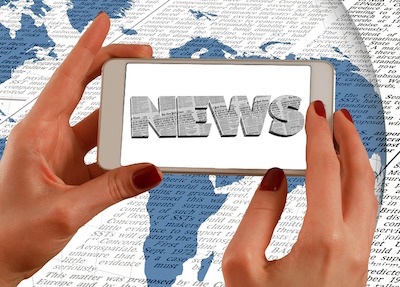For newspaper publishers, striking gold in the digital realm in 2017 means so much more than just a slick new website or improved page views.
Today’s online readers want engagement, personalisation and specialised content that can’t be found anywhere else. The task of developing new and effective digital plans of action may seem like a daunting task, but here are six digital strategies for newspapers to consider employing this year.
-
Personalise email newsletters
Personalising email newsletters doesn’t mean simply attaching the reader’s name at the top of an email. Users not only want a customised experience, but they would prefer it to have it delivered to them with little to no work on their end. Think of it this way — why hand over one item to every single person when not every one of them want the same product?
This question was the focus of recent Reynolds Journalism Institute Fellow Tracy Clark’s research and pilot project with the Austin American-Statesman in Texas. Over the course of a six-month period, Clark compared the results of a personalised newsletter and the paper’s standard editor-selected newsletter to its readers. The data left little ambiguity over what people wanted.
According to Clark, the personalised newsletter had twice the open rate and three times the click rate of the standard newsletter. The customised newsletters were delivered on Clark’s Reportory platform, an a-la-carte customised news platform that publishers can use to provide personalised news to their readers.
“What if you can just have one platform where the people curate their own news and the newsletter was based on that?” Clark said. “My hope is that Reportory can be white labelled by some of the major newspaper groups who can then offer it to their readers.”
However, Clark wasn’t the only one in the industry who recognised the potential of news personalisation. Last April, Crain Communications announced that its new city brands would feature “smart email newsletters that customise business news based on location, reader preferences and engagement.” Meanwhile, The Washington Post experimented with ‘pop-up newsletters’ as a way to showcase enterprise projects. The emails were targeted at users who, based on their reading history, were likely to have a strong curiosity in the topic.
“It is a valuable tactic because relevant content is one way to get reader’s to open publisher emails and click through to your content as well as relevant advertiser messages,” said Penny Merian, chief marketing officer of HubCiti, a developer of mobile apps. “It has been proven to significantly boost open rates and click through rates.”
-
Shift the mentality from advertiser first to user first
It may seem like a counterintuitive approach toward building a digital presence, but newspapers should look to shift their mentality from an advertiser first to a user first strategy.
“It’s been our observation that an ‘advertiser-centric’ digital business model tends to debase the value of the newspaper’s content,” said Matthew Larson, vice president of sales and marketing for Our Hometown, Inc, a digital publishing platform and newspaper CMS. “Publishers end up giving away a large percentage or all of their digital content in order to boost page views and maximise ad revenue. The problem is they are then competing with the other free digital news and information services out there for advertising dollars, which is a battle they cannot win.”
Larson says newspapers can use Our Hometown to provide seamless access to paying subscribers on all devices and offer digital-only features, such as photo galleries and business directories.
“The bottom line is newspapers can still foster healthy digital traffic for advertisers by acting as a communication hub in their community, without giving away their editorial content and cannibalising the print edition,” Larson said.
It’s a mindset that Lisa Strattan, senior vice president/executive editor and publisher of Wicked Local, said was kept in mind during the revamp of Wicked Local’s websites.
“We believe that an excellent user experience creates an environment that provides higher value to advertisers with fewer but more meaningful and more effective ad units,” Strattan said, who also serves as executive editor of the Patriot Ledger and The Enterprise in Massachusetts. “By turning down the ‘noise’ on our sites, we’ve achieved greater impact for our advertisers.”
Thad Swiderski, president of eType Services, a digital solutions company for community newspapers, said that publishers who are able to make their users the priority will have an improved chance of converting at least a portion into paying subscribers.
-
Develop your own specialised websites
Prior to the internet, newspapers were unquestionably the experts on their local communities. Why can’t that still be the case in 2017?
Last year, the Arizona Republic launched Street Scout, a stand-alone real estate valuation site with local information and community guides created by their newsroom.
Keira Nothaft, the Republic’s director of digital innovation, said she and her team recognised a specific need for a reliable local real estate authority. Street Scout was profitable almost immediately after launching and has since received more than 3 500 emails and calls from homeowners, renters, real estate agents and others using the site. Plans for Street Scout in 2017 include a new real estate news page, a personalised dashboard that includes a graphic of your home valuation over time, plus community news feeds and the ability for neighbourhood discussions and interaction.
“Real estate is Arizona’s biggest industry and buying a home is one of life’s biggest decisions,” Nothaft said. “While there are well-funded, high-traffic national competitors in this space, we knew we could do better and that we needed to do better.”
In some cases, publishers should look to recent changes in local or national laws that may have a direct impact on its readership. Following California’s legalisation of recreational marijuana last November, Digital First Media launched The Cannifornian as a resource to explain the societal, economic, political and cultural impacts of cannabis.
The Boston Globe’s STAT, which launched toward the end of 2015 as a website devoted solely to covering medicine and health news, recently introduced a $299-a-year premium plan for professionals working in the pharmaceutical and biotech industries. Ultimately, if high-quality premium content is continuously produced by a newspaper, readers will be willing to pay for it.
-
Work with – not against – Facebook, Amazon and Google
Facebook, Amazon and Google are commonly seen as the enemy by newspaper publishers for good reason. But what if instead of fighting the big three, you embrace them? Finding a way to partner with companies and apply new technology as part of your digital strategy is a concept newspapers should certainly at least consider.
Two major newspaper groups, Hearst Newspapers and GateHouse Media, are already both using Amazon Echo. In addition to adjusting your lights, checking the weather and playing music, the Echo device can now read aloud the top headlines and a summary of the stories from participating newspapers.
“In each market, our current subscribers as well as non-subscribers will have access to top stories from their local paper delivered by Alexa as part of their daily briefing,” said Alain Begun, vice president of marketing for GateHouse Media. “It will also allow consumers outside of a given market access to the top stories from any of the 400-plus GateHouse markets. So, for example, snowbirds home for the summer, can still keep up-to-date with what’s happening in their Florida second-home town.”
Another featured introduced by Google in 2016 was its ‘local source’ tag to promote local coverage of major stories. In its announcement on the Google News blog, the company said the tagging aspect is automated based on “looking at where a publisher has written about in the past and comparing that to the story location.”
When it comes to Facebook Live, the success of papers like the New York Times, which surpassed 100 million views last year in 2016, should further emphasise its importance to publishers. The social media site’s latest technology offering, Facebook Live Audio, can also be used by newspapers to post exclusive online interviews as well as live recaps and podcasts following a sporting or prominent event.
-
Make digital fact checking an even bigger priority
While the importance of fact-checking is a given for traditional newspapers, it saw an even greater resurgence during the last US presidential election. Though several months have since passed, its value shouldn’t be overlooked.
Last September, First Draft launched a global Partner Network consisting of newsrooms, fact-checkers, human rights organisations and technology platforms in an effort to improve how information is reported and verified. Participating newspapers include the New York Times, the Washington Post and the Guardian. First Draft’s Claire Wardle said the ultimate goal of the partner network is to raise knowledge and standards of verifying information, put them into practice and share what they learn.
“With local newsrooms struggling financially, the biggest concern is who or what will be able to keep local politicians and institutions accountable,” Wardle said. “So if a local newsroom can resource a fact-checking column or segment, it sends an important message to politicians that they are being watched and to audiences that there is a space where claims and statistics will be investigated and explained clearly.”
Several newspapers and organisations have already gotten to work on this issue. A few weeks after the election, the Washington Post released a Chrome plug-in intended to fact check posts from Donald Trump’s Twitter account. The RealDonaldContext plug-in adds a grey box to every Trump tweet and clarifies or adds important context to misleading posts made by Trump.
Meanwhile, French newspaper Le Monde is currently working on tackling fake news by having its 13-person fact-checking division within the newspaper develop a ‘hoax busting’ database. The paper already maintains a search engine for its readers to check statements made by politicians.
-
Explore the capabilities of chatbots
To say that chatbots and robot journalism have yet to fully take shape wouldn’t be an inaccurate statement. However, to simply disregard their potential capabilities would be foolish.
Last summer, the Washington Post released a chatbot for the Facebook Messenger platform as a way to feature top news stories, election alerts and Olympic coverage. Users were able to engage the bot which then responded with command options. During the Rio Summer Olympics, the chatbot provided information such as medal counts, alerts and the television schedule.
A few months later, the Globe and Mail launched a similar experiment using its ‘GloBot’ Facebook Messenger chatbot built around providing information on the US election. The bot was designed to send readers who signed up one message a day related to the paper’s coverage of the election. Occasionally, GloBot even offered up a quiz question for readers
The Knight Foundation has also taken notice, announcing a $240 000 grant in support for the Quartz Bot Studio to advance understanding of “bots, AI and related technologies for journalism on new platforms”. The studio ultimately plans to share what they learn to the public.
Sean Stroh is an assistant editor at Editor & Publisher Magazine, America’s oldest journal covering the newspaper industry.














